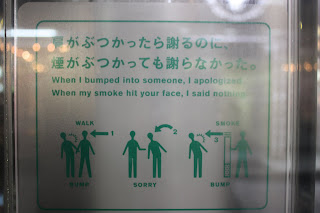By Jun and Alex
Our travels in our first two days in Japan took us to the Shinjuku and Harujuku areas in Tokyo. Keeping our eyes out for any kinds of Engrish, there were many instances of well-translated Japanese. However, we noticed a fair amount on English translations could be found on official public information sources. Case in point: a standing ashtray.
Standing ashtrays such as this one are offered to encourage smokers to smoke in way that is considerate of others (e.g. preventing second-hand smoke exposure, preventing littering, etc.). What we found interesting was the way in which this request was made on the standing ashtray. Different pieces of information were presented on separate panels.
The English translation of this message is quite a literal translation of the original Japanese, which is basically asking smokers to be aware that the cigarette they’re carrying is hot and to take care when smoking to not accidentally burn someone around them with their cigarette. From a North American perspective, we found the use of a first-person perspective in the English translation somewhat odd; in Canada, such a message might use something like, “You are carrying a 700°C fire; please be careful” rather than, “I am carrying a 700°C fire.” However, the first-person perspective may be used to elicit a greater willingness from the smoker to follow the suggestions by speaking to them on a similar level, rather than acting as a direct order for them to follow (which may induce resistance). While there is nothing grammatically wrong with this translation, it is actually an accurate literal translation of the Japanese, though some of the implication is lost which may explain why we find it a bit odd.
In this example, the first-person perspective is again used, and offers a much more passive request to be considerate of others when smoking. This may be indicative of the culture of Japan, where respect is regarded as extremely important.
First, when we saw this sign, we were a little confused as to what the real message was. The English translation matches the Japanese quite well in a literal sense; basically, it says that when you dispose of a lit cigarette, you’re just making more smoke (like an incinerator). The inherent meaning, however, is that if you dispose of cigarettes in the standing ashtray without extinguishing it, the cigarette is still going to give off smoke that can bother people. We found it a bit odd that they separated “stand ashtray” from the second sentence, rather than integrating it into the second sentence like, “Disposing of a lit cigarette in a standing ashtray just creates more smoke.” However, this was done because “stand ashtray” is a literal translation of the first Japanese sentence. From a Japanese perspective, this may sound quite normal, but to us, it sounds odd, thus furthering the general trend of literally translated Japanese that loses some of its implicit meaning. In addition, “stand” should be translated as “standing” to act as a proper adjective.
Here, the original Japanese reads something like, “The way the smoke travels. Except for the smoker, other people are bothered (by the smoke).” While the first sentence in Japanese is not a question, it has been reworded as a question in the English translation to sound more natural. As such, the translation is less literal but carries the implicit meaning in the original Japanese more clearly than some of the other signs.
While the English translation here is grammatically correct and explains the original Japanese very accurately, it is quite an odd message. Some in our class thought the sign was pro-smoking in presenting a cigarette as having feelings. The other opinion that was suggested was that the personification of the cigarette was meant to evoke some feeling in the smoker to properly dispose of their cigarette, rather than just tossing it away as if it had no emotions (which, admittedly, it doesn’t). Jun thought that the message discouraged smoking because the message suggests that it is harsh to the cigarette when the smoker throws it away, so why not stop smoking it from the beginning? On the other hand, Alex thought that the sign was trying to indirectly tell the smoker to properly dispose of their cigarettes, because tossing it out on the street is just “rude” to the cigarette. The attempt to personify the cigarette as a person may reflect the highly passive and indirect nature of communication in Japan; rather than directly telling a smoker to properly dispose of their cigarettes, an ambiguous message is used instead to suggest something else. In any case, this is another excellent example of perfectly translated Japanese that holds a very odd meaning for Westerners.
The original Japanese in this last picture can be literally translated as, “The hero carelessly threw away his cigarette. This was in an old movie.” The message implies that only characters in a movie will do something as careless as throwing their cigarette on the street; as you are not the hero in an old movie, you shouldn’t casually toss out your cigarette, but use the ashtray.
Overall, we found that the English on the ashtray consisted of direct literal translations of the original Japanese, and while grammatically correct, these translations sounded odd to us and lacked the implied meaning in the Japanese. The tone of the English seems to reflect the tendency of Japanese people to not make direct requests for certain things. As a public information source, it would be expected that the English translation would be faithful to the original Japanese; however, in our example of the ashtray, some translations do not entirely convey the implicit message in the original Japanese.







No comments:
Post a Comment